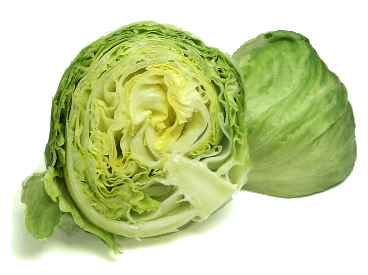There are some vegetables, which are consumed uncooked state and are called salad crops. Salad crops are now more popular because of their food value in the diet. Lettuce is the most popular of the salad crops. It is most commonly used in the U.S.A., but in India it is yet to gain popularity. Lettuce derives its name from the milky juice ("latex") referring to the plant's milky juice. Lettuce leaves contain small amounts of opiate-like substance, lactucarium ("lettuce opium"), which is a mild sedative. Several health-building qualities and many medicinal virtues are contained by lettuce. The loose leaf lettuce is regarded as better food because it is rich in iron and also has more vitamin A and C than the stem variety since it is more exposed to the sun. Greener leaf has more chlorophyll and vitamins. It has rich contents of mineral salts especially the alkaline elements. Lettuce used for consumption should be fresh green-leaved. All lettuce is a good source of chlorophyll and vitamin K. Iceberg lettuce provides a good source of choline. Romaine lettuce is the most nutrient-dense of all the lettuce varieties and is an excellent source of vitamins A, B1, B2, and C, folic acid, manganese and chromium. Since lettuce is very low in calories, it has been effective when consumed as a diet food. Due to its high water content, lettuce provides little health benefits beyond its nutrient content. It is most often grown as a leafy vegetable, but sometimes for its stem and seeds. Lettuce is most often used for salads, although it is also seen in other kinds of food, such as soups, sandwiches and wraps or it can also be grilled.
Types
There are four distinct types of lettuce.
1. Head type variety Capitata - Butterhead and Crisphead,
2. Leaf type variety Crispa,
3. Cos type variety Longifolia,
4. Asparagus type variety asparagus.
Varieties
Iceberg, Great lakes, Bogampo, L-S-1, L-S-2
Climatic requirements:
Lettuce does well in a relatively cool growing season with a monthly average temperature of 12oC to 15oC. High temperature promotes seed stems, cause a bitter taste in the leaves, and accelerate the development of tip burn and rot. head lettuce rots in hot, rainy or humid weather. The seed does not germinate properly when the soil temperature is above 30 °C.
Soil and Manurial requirements
It performs best when grown on a rich, friable soil. Soils rich in organic matter have a high water holding capacity and ensure uniform moisture supply. It is sensitive to high acidity. The best soil reaction is pH 5.8 to 6.6.
Fertiliser: The fertilizer requirements will vary with the soil. However, on an average, 100 kg of nitrogen and 60 kg each of phosphate and potash per hectare when applied give good results.
Sowing
The plants are generally sown in the nursery bed first but sometimes some types, especially the leaf types are sown directly in the field. The nursery sowing is done in September - October and transplanted when the seedlings are five to six weeks old. About half a kilogram of seed is required for raising seedlings for one hectare. In the hills, the seeds are sown from February to June.
After Care
Hoeing and weeding are intermittently done for proper aeration and keeping down the weeds. Water should be supplied to keep uniform moisture conditions in the soil. Drainage is an important as supplying irrigation, for excess of soil moisture may cause rotting.
Harvesting
Leaf lettuce
The varieties are usually allowed to develop full size though they are often cut soon after they are half grown.

Head Lettuce
These are harvested when the heads are well formed, of good size, and solid. While handling, care should be taken, not to damage the wrapper leaves. Lettuce can be kept for two to three weeks at 0 oC and 90-95% relative humidity.
Insects Pests and Their Control
Aphids are the most troublesome insect pests on lettuce. The use of 3 to 4 percent nicotine dust gives satisfactory control if applied when the temperature is around 18 oC to 21 oC.
Diseases and Their Control
Slimy soft rot: It is severe in head lettuce. It is controlled by early removal of the heads and also by keeping the soil uniform in moisture and the surface soil relatively dry.
Downy Mildew
The first symptoms are the appearance of light green or yellowish spots on the surface of leaves. A downy white growth appears on the underside of the leaves. It can be controlled by use of resistant varieties.
Mosaic
It is first noticed at the seedling stage. There is a slight inward rolling of the leaves along the main axis followed by a light green to yellow mottling of leaves. There may be severe stunting and a dull green to slightly yellow discolouration of the whole plant. The disease is seed borne and use of disease free seed is the only control measure known so far.
About Author / Additional Info:
I am working in the improvement of lettuce.
Image source: www.foodsubs.com/Greensld.html